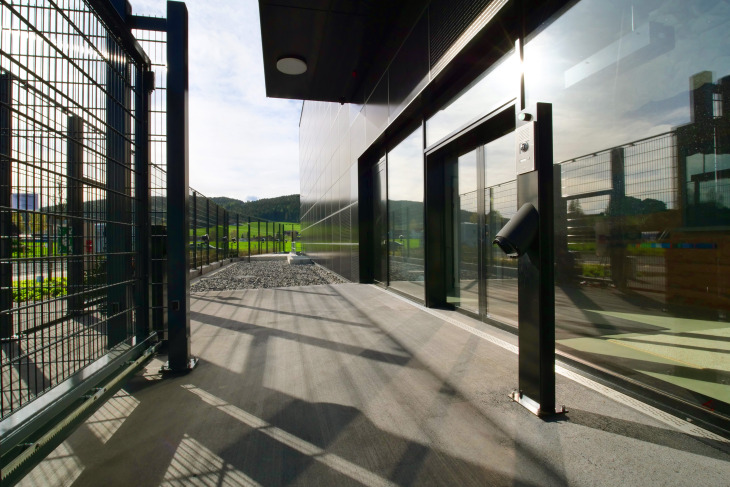RZO data centre: Sustainable solution involving free and adiabatic cooling from Hoval

RZO data centre: Sustainable solution involving free and adiabatic cooling from Hoval
At its site in the Swiss village of Gais, RZO AG operates not only the most secure, but also the most energy-efficient data centre in the region. When it comes to cooling the sensitive IT infrastructure, the company puts its trust in a Hoval solution.
- Data center
- New Building
Right in the heart of the Appenzellerland region, a black, cube-shaped building stands in marked contrast to the picturesque backdrop of the landscape. Covering an area of 900 m2, the Rechenzentrum Ostschweiz data centre (RZO) offers businesses, public institutions and service companies alike the opportunity to outsource their IT infrastructure to an expert partner. With an availability of 99.998%, the RZO meets the Tier IV classification of the Uptime Institute, which is regarded as the gold standard in data centre availability. Anyone who enters the site will soon become acquainted with the comprehensive security concept: continuous video surveillance, biometric access monitoring and a personnel airlock ensure that the data centre equates to a strictly controlled safe haven for data.

At its site in the Swiss village of Gais, RZO AG operates not only the most secure, but also the most energy-efficient data centre in the region.
Protection of sensitive IT components

Storage devices, servers, network components: there generally need to be several of each of the components required to operate the data centre. When they are running, they generate considerable amounts of heat – a fact that needs to be considered early on in the design of a data centre, as Jan Isenegger, Operations Manager at RZO emphasises: “Only Hoval was able to meet our requirements of using the principle of free cooling all year round – by this, we mean working entirely without compressors or refrigerants.” The solution in Gais consists of 10 Hoval ServeCool compact units, which air-condition the data centre in line with demand using free and adiabatic cooling. This is possible as the units provide a constant temperature and humidity level, enabling them to reliably protect the sensitive IT components. “Cooling also forms part of a data centre’s safety and security concept,” highlights Stefan Kuch, Segment Manager for Data Centres at Hoval. “In the unlikely event that a unit fails, the others take over the cooling load.” A look inside reveals that the separation of the airflows in the highly efficient twin plate heat exchanger not only protects the sensitive IT infrastructure against humidity but also against dust and dirt. With free cooling, the ServeCool unit draws in the cool fresh air. This flows through the two cross-flow plate heat exchangers, cools the supply air flow indirectly and is then blown back outside.
Only Hoval was able to meet our requirements of using the principle of free cooling all year round.
Adiabatic cooling aided by rainwater
Due to its location almost 1000 metres above sea level, the fresh air temperatures in Gais are cooler all year round – circumstances that have a highly positive impact on the data centre’s energy footprint. Yet even on warmer days, resource-efficient cooling runs without a hitch, as that is when the ServeCool units automatically add in the adiabatic system. For adiabatic cooling, also known as evaporative cooling, rainwater is also used in the fresh air circuit to further reduce the supply air temperature and boost cooling capacity. Water enters the fresh airflow via nozzles, similar to in a shower. The rainwater can be stored in a cistern and its low conductivity makes it the ideal medium for adiabatic cooling.
Minimum space, maximum flexibility

Space in a data centre is valuable and needs to be used effectively – another argument in favour of the ServeCool compact units, which each have a footprint of just 14 m². What’s more, ServeCool has a modular design, as Stefan Kuch highlights: “The system’s capacity can be expanded as required at any time by linking several units in a flexible manner. This provides flexibility for the future if the cooling capacity required in the data centre increases.”
Sustainability across the board
Around 1 500 000 kWh can be saved annually by utilising waste heat – that’s the equivalent of around 70000 m³ of natural gas or 360 000 kg of CO2.
Impressive control system and service
Every single one of the installed ServeCool units has the in-built control system it needs for operation. “The graphical user interface – or GUI for short – means I can keep track of cooling within the data centre at all times, including via my web browser. It’s great that the visualisation has been kept simple and is intuitive to use,” says Isenegger, highlighting the system’s user-friendliness. In terms of ongoing care, too, the company feels in good hands with Hoval. “It’s clear that the ServeCool units are not only energy-efficient, but also low-maintenance and easy to service, as the components are easily accessible,” says Isenegger and summarises: “Our solution for free and adiabatic cooling runs stably and my contacts at Hoval are always on hand if I have any questions.”
Image credits: Rechenzentrum Ostschweiz
